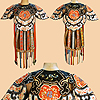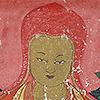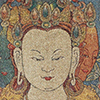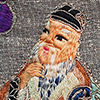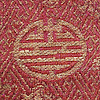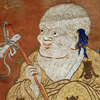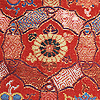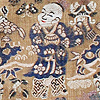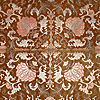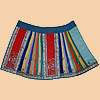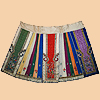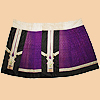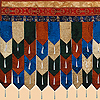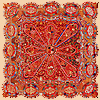A thangka is a Tibetan Buddhist painting on cotton, silk, or canvas, usually depicting a Buddhist deity, scene, or mandala. Thangkas are traditionally kept unframed and rolled up when not on display, mounted on a textile backing somewhat in the style of Chinese scroll paintings, with a further silk cover on the front. So treated, thangkas can last a long time, but because of their delicate nature, they have to be kept in dry places where moisture will not affect the quality of the silk.
Thangkas serve as important teaching tools depicting the life of the Buddha, various influential lamas and other deities and bodhisattvas. One subject is the Wheel of Life (Bhavachakra), which is a visual representation of the Abhidharma teachings (Art of Enlightenment). The term may sometimes be used of works in other media than painting, including reliefs in metal and woodblock prints. Today, printed reproductions at poster size of painted thangka are commonly used for devotional as well as decorative purposes. Many thangkas were produced in sets, though they have often subsequently become separated.
Thangkas are typically painted by highly skilled artists called thangka painters. The process of creating a thangka is a long and meticulous one, and can take months or even years to complete. The artist begins by preparing the canvas, which is usually made of cotton or silk. The canvas is then coated with a layer of gesso, which provides a smooth and even surface for the painting.
The artist then begins to paint the image, using a variety of traditional Tibetan pigments. The pigments are made from natural sources, such as minerals, plants, and insects. The artist uses a variety of brushes and other tools to create the intricate details of the painting.
Once the painting is complete, it is typically mounted on a textile backing and covered with a silk cover. Thangkas are often decorated with gold or silver leaf, which adds to their beauty and significance.
Thangkas are an important part of Tibetan Buddhist culture. They are used in a variety of ways, including for meditation, worship, and instruction. Thangkas are also highly prized works of art, and are often collected by art lovers around the world.
Here are some of the most common types of thangkas:
Deity thangkas: These thangkas depict a particular Buddhist deity, such as the Buddha, Avalokiteshvara, or Tara. Deity thangkas are often used for meditation and worship.
Scene thangkas: These thangkas depict a particular scene from Buddhist mythology or history. Scene thangkas can be used for teaching and inspiration.
Mandala thangkas: Mandalas are sacred geometric diagrams that represent the universe. Mandala thangkas are often used for meditation and visualization.
Thangkas are a rich and complex art form with a long and fascinating history. They are a valuable part of Tibetan Buddhist culture, and continue to be admired and appreciated by people around the world.
